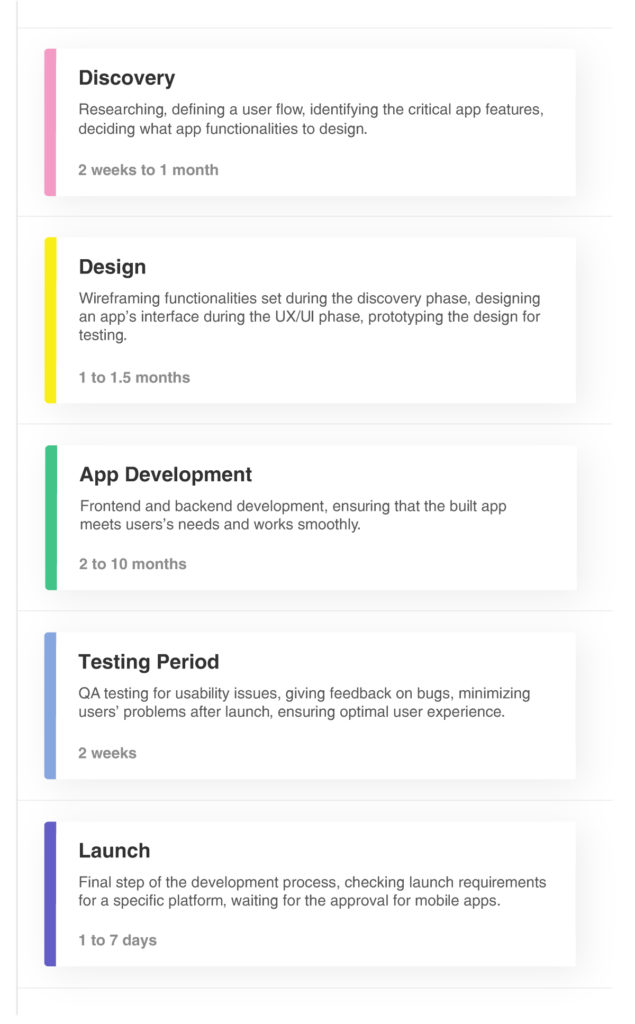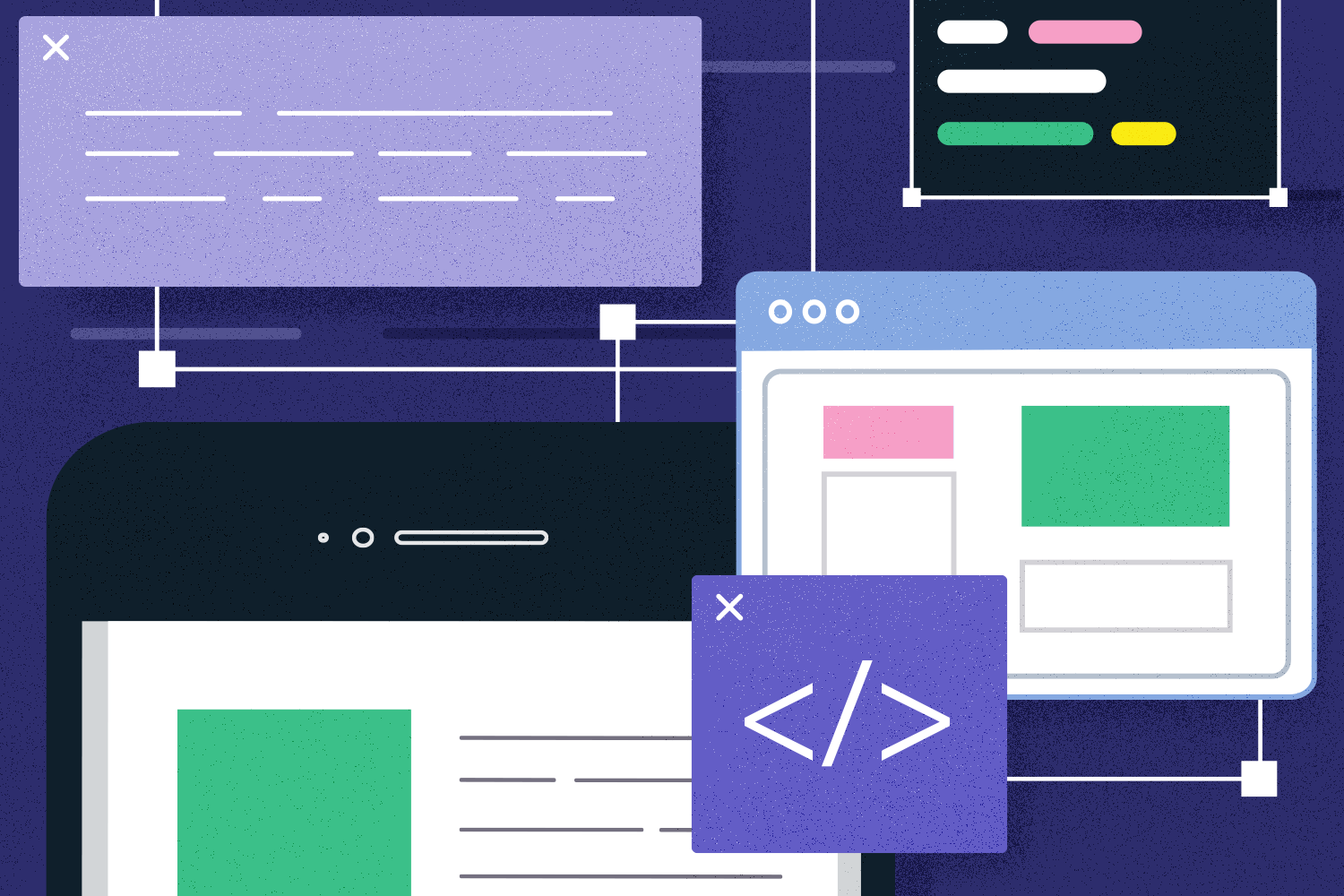Tech devices are the most easily accessible source of information and are the tool with the highest user interaction level.
In today’s technology-driven world we live in, apps are a significant part of our lives. They are a handy tool that can enhance a person’s life, productivity, and enjoyment. Apps are also regularly used by large and small companies to streamline production, attract new users, increase work ease and improve the business.
The term “application” is extensive and covers a lot, from impressively complex technological tools to almost straightforward gadgets.
Whenever you plan to build an app, the first and foremost question that probably comes to your mind is the time it takes to develop an app. This is a question you will always come across when discussing application development.
The duration may vary based upon the project’s scope, app complexity, and the process you follow. It all depends on how well and long you plan, organize and implement the overall process. In this article, we will show you how long it takes to complete the app.
How long does it usually take to develop an app?
Today’s market needs and demands greatly influence the building of an app for your business. Customers are looking for functionality, simplicity, mobility, and convenience.
You need to carefully plan and understand the app development process and apply reasonable strategies to estimate its timeline. This will help you find out how long does app development take.
It’s difficult to predict the timing needed to develop an app because it’s like asking someone how long the piece of string is. Apps are bespoke pieces of software, each different and individual. There are simple apps and complicated apps, some that use few functions and some that use loads of them, some that only display data like a web page, and some use the camera, social media integration, etc.
The time required to create an application depends on several factors – the size, complexity of the application, and its features. Complicated apps will need longer to develop. If we speak about smaller or more simple apps, it can take two to four months, or slightly more.
Applications of medium complexity, for example, collaboration tools, will likely take six months or more to build. And when it comes to mobile apps, the whole process takes a lot longer.
Complex and sophisticated apps will need at least nine months of development, depending on the business’s project and ambitions scale. Such apps usually have a couple of advanced features like AI components, AR, machine learning, unique interface, etc. These are apps like Google Drive and Uber.
To answer a question, “how long does it take to develop an app” usually depends on “what does it take to create an app of different complexity”.
Pro tip: Make sure you have an experienced team working on your app. Otherwise, it can get delayed.
In Async Labs, we’ve worked on projects that took as little as six weeks and the longest one that took three years. It really can vary depending on the scope of the project.

How do you make an app step by step?
The most important thing is to focus on the process you go through and break that process down into phases. Let’s see how an app development timeline and process look like in practice.
Discovery
Time frame: 2 weeks to 1 month
Before you start the work, set a goal. Clearly state your app’s purpose and conduct market research of the potential app competitors. Focus on your actual end-users, check who they are, talk to them, and determine what value they want to gain from your app. This part can take from one to two weeks.
Use the information you gathered from end-users and build a user journey map to see how they will interact with your mobile app. This involves user interviews, surveys, and competitive analysis and can occupy another one to two weeks of your time.
Few steps need to be successfully completed:
- Researching users’ motivations, problems and expectations of the way they want to use an app
- Drawing the probable user flow that will show how users navigate through your application.
- Identifying the critical app features
- Deciding what app functionalities to design
Design
Time frame: 1 to 1.5 months
This is an integral part of the app development process. The product design phase helps determine how the application may look and function to meet the user’s needs.
The more information you collect and the more requirements you define, the more time you will save in the latter process and the need for change will be minimized. Good communication between all parties helps to avoid misunderstandings and makes the project run smoothly.
Now it is time to work on UI/UX design and visually appealing and easy-to-use mobile functionalities. This process framework includes a user interface (UI) and user experience (UX) parts. UI/UX designers’ have a task to find the balance between a product and its value to the target audience.
Designers create prototypes and wireframes, which takes approximately two weeks.
In this phase, based on wireframes, designers create interactive yet straightforward user interfaces for applications during the UI design (user interface) stage.
Prototypes should be low-cost and straightforward, allowing users to interact with the app. It should take approximately one week to develop these mock-ups.
App development
Time frame: varies from 2 to 10 months, depends on project complexity
During the app development phase, designers and developers work together to ensure that the built app meets users’ needs and works smoothly on both back-end and front-end parts. Everyone in the team knows exactly what they’re building and how.
Key elements for back-end design:
- Requirements: Define servers and databases you need
- User management: How will you authenticate users and manage accounts
- Data synchronization: Allowing offline app usage.
- API integration: We usually develop APIs ourselves, but sometimes we hook into existing APIs. We need to understand how they work and how it impacts the product or solution we are implementing and designing.
- Push notifications: Will the app utilize push notices to interact with users?
The front-end is the conversion of UX/UI design into a functional visual part of the application.
Front-end design includes the following activities:
- Data caching: Locally storing data to improve the speed and performance.
- Analyzing: Design, code, and debugging applications along with ensuring a flawless user experience.
- Application Interface: According to UX and UI design, the design is transcribed into code.
- Features: Keep it simple because unnecessary items will only slow down the launch.
Testing period
Time frame: 2 weeks
A bug that goes unnoticed can cause significant usability issues and become more expensive to fix over time. The QA team has to test the app to eliminate bugs before they reach production servers, minimize users’ chances of encountering any problems, and ensure an optimal user experience.
Now let the users use the app and collect their feedback. It is crucial to set the testing plan at the very start and capture problems early on. The ideal situation is to test the app as soon as possible and send detailed feedback to developers.
Launching app
Time frame: 1 to 7 days
This is the final stage of the app development process. After being well tested, it takes almost a week to launch the app. The more skilled, educated, and experienced software engineers you work with, the faster you will launch your app. It is also important to note post-launching support and maintenance. This part includes support and careful app observation by the team to manage all unexpected and unusual behavior. As long as the company is interested in excellent users’ experience, this stage is essential.
When it comes to mobile apps, keep in mind that publishing requirements for the App Store and Google Play are quite different. The launching process can take up to a week because an app needs to go through the Google Play Store and Apple App Store review process and meet the necessary criteria.
How to save time and launch your app faster?
Build an MVP (Minimum Viable Product) first
MVP is a version of the app that functions at the most basic level and its core functionality. Minimum Viable Product shrinks the app development timeline and gets your product faster to the market.
The right software development methodology
For app development, we usually gladly recommend the agile approach. The agile approach is a project methodology that takes an iterative process towards completing a project. It aims to create early, measurable ROI through defined, iterative delivery of product features. This approach will get your product to market faster, with guaranteed quality.
Skilled team
A skilled team will follow all of the appropriate steps in the app development process and deliver a successful product in the least amount of time.
To determine how long to make an app, follow these proven business strategies and conduct them step by step on a high level. There are simple apps built within only two months, but more complex apps with more features, functionality, and detailed design may take 6-8 (or even more) months.
The answer to the question How long does it take to develop an app depends on many factors we discussed above. There is no unique and straightforward answer because developing an app is a complex process.
Do you have any additional questions or need extra information or advice regarding your next project? Contact us via email and plan your smart app development with Async Labs! We will be glad to provide professional consultation and find a suitable approach to improve your brand and market position.
Got any tips on building your first app and how long it took you? Let us know by reaching us at hello@asynclabs.co.
